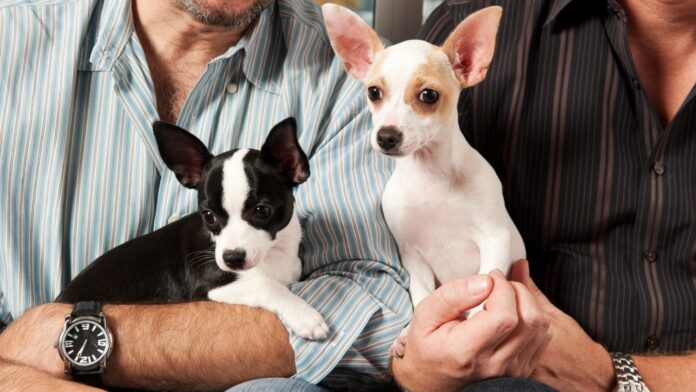Introduction to Can Dogs Be Gay
Dogs are more than just pets; they’re complex creatures with intricate social behaviors that can sometimes be puzzling to their human companions. Among these behaviors, the question, Can dogs be gay?, often arises, sparking both curiosity and confusion.
This topic, while seemingly light-hearted to some, actually touches on deeper aspects of animal behavior and our understanding of sexuality in non-human species. To address this question fully, it’s essential to delve into what drives canine behavior and how it differs from human experiences of sexuality.
Understanding that dogs don’t operate under the same social and sexual constructs as humans is key. This article will explore canine behavior in-depth, dispelling myths and providing insights into why dogs exhibit certain behaviors that may seem, at first glance, like same-sexuality attraction.
ALSO READ: Why Do Dogs Sniff Butts: The Science and Social Significance
Understanding Animal Sexuality: Beyond Human Concepts (Can Dogs Be Gay)
When discussing animal behavior, especially concerning sexuality, it’s important to approach the subject with an understanding that animal sexuality is fundamentally different from human sexuality. This distinction is crucial for interpreting behaviors accurately and avoiding the pitfalls of anthropomorphism—attributing human characteristics to animals.
The Difference Between Human and Animal Sexuality (Can Dogs Be Gay)
In humans, sexuality is often seen through the lens of orientation—heterosexual, homosexual, bisexual, etc. This categorization reflects complex social, emotional, and psychological components. However, in animals, including dogs, sexual behavior is not tied to an identity or orientation in the way it is for humans. For animals, these behaviors are primarily driven by instinct, social structures, and environmental factors.
For example, in the wild, many species engage in sexual behaviors that are not strictly for reproduction. These can include acts of dominance, social bonding, or even conflict resolution. In this context, what we perceive as “gay” behavior in dogs is often part of a broader range of natural behaviors that have little to do with sexual preference.
Common Behaviors Observed in Animals (Can Dogs Be Gay)
Throughout the animal kingdom, same-sex behavior is not uncommon. From dolphins to birds to primates, animals engage in same-sex interactions for a variety of reasons. In many cases, these behaviors are observed in species that live in close social groups where bonding and hierarchy are crucial.
In dogs, behaviors such as mounting, licking, or affectionate gestures towards the same sex are frequently observed. However, these actions are typically rooted in social interaction, play, or establishing dominance rather than sexual desire.
Sexual Behaviors vs. Dominance Behaviors (Can Dogs Be Gay)
In canine behavior, it’s critical to differentiate between sexual behaviors and dominance behaviors. Mounting, for instance, is often misinterpreted as a sexual act when, in reality, it’s frequently a demonstration of dominance or a reaction to excitement or stress. This behavior can be seen in dogs of any gender and doesn’t necessarily indicate a sexual attraction.
This dominance-related mounting can occur in various situations, such as during play or when a new dog is introduced to the group. It’s more about establishing social order than expressing a sexual preference. Understanding this helps clarify why labeling a dog as “gay” based on these actions is a misunderstanding of canine behavior.
How Researchers Study Animal Sexuality (Can Dogs Be Gay)
Researchers approach the study of animal sexuality by observing behaviors in natural or semi-natural settings, looking for patterns that might indicate specific social or reproductive functions. These studies often involve long-term observations, allowing scientists to differentiate between behaviors that are sexually motivated and those that serve other purposes, such as social bonding or establishing dominance.
It’s through these observations that researchers have come to understand the broad spectrum of behaviors animals engage in, including those that might be perceived as same-sex interactions.
Canine Behavior: What Do We Know (Can Dogs Be Gay)?
Dogs, as social animals, have a complex set of behaviors that help them navigate their social world. Understanding these behaviors within the context of canine social structure is crucial for interpreting what we see as their “sexuality.”
Basic Overview of Canine Social Structure
Dogs, descended from wolves, have retained many of their ancestors’ social behaviors. In the wild, wolves live in structured packs with a clear hierarchy, and many of these hierarchical behaviors are evident in domestic dogs as well. This hierarchy influences interactions between dogs, including those that might appear to be sexual.
In a pack, dogs will establish their social order through various behaviors, including play, grooming, and yes, mounting. These actions help to reinforce bonds and determine each dog’s place within the group. Understanding this social structure is key to understanding why dogs behave the way they do.
The Role of Dominance and Submission in Dog Behavior (Can Dogs Be Gay)
One of the most common misconceptions about canine behavior is that all mounting is sexual. In reality, mounting is often a display of dominance. When a dog mounts another dog, it’s usually asserting its position in the social hierarchy. This behavior can happen between dogs of any gender and is not limited to what humans would consider sexual contexts.
Submission is the other side of the coin. Dogs display submissive behaviors, such as exposing their belly or lowering their body, to communicate their willingness to defer to a more dominant dog. These interactions are vital for maintaining harmony within the group and are part of the natural social dance that dogs perform.
Play Behavior vs. Sexual Behavior in Dogs
Play is an essential part of a dog’s life and serves many purposes, including social bonding, practicing adult behaviors, and expending energy. During play, dogs often engage in behaviors that mimic adult activities, including mounting, chasing, and wrestling.
It’s important to note that play behavior, while it can look similar to sexual behavior, is usually about having fun and learning social cues rather than expressing a sexual interest. This is why it’s common to see dogs of the same sex engaging in play that includes mounting or other actions that might be misinterpreted as sexual.
Common Misinterpretations of Canine Behavior
Given the differences between human and canine behavior, it’s easy to misinterpret what our dogs are doing. For example, two male dogs mounting each other might seem like a display of sexual attraction, but in the canine world, it’s more likely a way to establish dominance or simply part of play.
By recognizing these behaviors for what they are—normal expressions of dog social structure and interaction—we can better understand our pets and avoid jumping to conclusions based on human concepts of sexuality.
Same-Sexuality Behavior in Dogs: What Does It Mean (Can Dogs Be Gay)?
Same-sex behavior in dogs is a common observation that can occur in a variety of contexts. These behaviors, while they might seem unusual or amusing to us, are often part of the normal range of canine interactions and should not be cause for concern.
Observations of Same-Sexuality Behavior in Dogs
Dogs often engage in behaviors such as mounting, licking, or playing with other dogs of the same sex. These behaviors are usually harmless and are part of how dogs communicate with each other. In many cases, they are a form of social interaction rather than an expression of sexual preference.
For instance, when two male dogs mount each other, it’s often a way of asserting dominance, establishing social bonds, or simply playing. These behaviors can be observed in various settings, including dog parks, homes with multiple pets, and even in shelters where dogs interact closely with one another.
Factors Contributing to Same-Sexuality Interactions
Several factors can influence the occurrence of same-sexuality behavior in dogs. One of the primary factors is social structure. In groups of dogs, especially those living in close quarters, such as in shelters or multi-dog households, establishing a social order is crucial. This social order is often maintained through behaviors that might include mounting or other displays of dominance.
Another factor is the environment. Dogs that are not neutered or spayed may display more sexually motivated behaviors due to hormonal influences. However, even neutered dogs can engage in same-sexuality behaviors as part of their social interactions.
Finally, individual personality plays a role. Some dogs are naturally more dominant, playful, or social, and these traits can lead to behaviors that might be interpreted as same-sex interactions.
The Significance of Non-Reproductive Sexual Behaviors
In the animal kingdom, not all sexual behaviors are about reproduction. Many species engage in non-reproductive sexual behaviors for social reasons. These behaviors help to strengthen bonds, resolve conflicts, and establish dominance within the group.
In dogs, non-reproductive sexual behaviors, including same-sex interactions, serve similar purposes. They are part of the complex social dynamics that dogs navigate daily. Understanding this helps to frame same-sex behavior in dogs as a normal part of their social repertoire rather than something that needs to be corrected or is indicative of a specific sexual orientation.
Comparing Same-Sex Behavior in Dogs to Other Species
Same-sex behavior is not unique to dogs; it’s observed across many species in the animal kingdom. For example, bonobos, a close relative of humans, are known for their same-sex interactions, which play a role in social bonding and conflict resolution.
In dolphins, same-sex interactions are also common and serve to strengthen social ties within the pod. These behaviors are a normal part of life for these animals and highlight the fact that sexual behavior in the animal kingdom is often more about social interaction than reproduction.
By comparing same-sex behavior in dogs to other species, we can gain a broader understanding of its role in animal societies and appreciate it as a natural and normal aspect of canine behavior.
Scientific Research on (Can Dogs Be Gay)
The study of same-sex behavior in animals, including dogs, has been an area of growing interest among researchers. While much of the research has focused on species like primates or birds, there is increasing attention being paid to understanding these behaviors in domestic animals.
Overview of Studies Conducted on Animal Sexuality
Research into animal sexuality has revealed a wide range of behaviors across species. These studies often involve long-term observations of animals in both natural and controlled environments. By studying these behaviors over time, researchers can identify patterns and better understand the social structures that drive them.
In dogs, studies have shown that same-sex behavior is relatively common and is part of their normal social interactions. These behaviors are not indicative of a specific sexual orientation but rather reflect the complex social dynamics at play.
Findings From Research on Same-Sex Behavior in Dogs
Studies on same-sex behavior in dogs have found that these interactions are typically related to social hierarchy, play, and bonding rather than sexual attraction. For example, a study published in the journal Animal Behavior found that mounting behavior in dogs is more about establishing dominance than sexual preference.
These findings are consistent with observations of other species, where same-sex behaviors are part of the broader social structure. The research highlights the importance of understanding these behaviors within the context of the animal’s social environment.
Limitations of Current Research
While there is valuable research on same-sex behavior in dogs, there are limitations to what we currently know. Much of the research relies on observational studies, which can be subject to interpretation. Additionally, there is a lack of longitudinal studies that follow the same group of dogs over time to see how these behaviors evolve.
Another limitation is the challenge of separating behavior that is sexually motivated from behavior that is driven by other social factors. This distinction is crucial for accurately interpreting the meaning behind these interactions.
Future Directions for Understanding Canine Sexuality
As interest in animal behavior and sexuality continues to grow, future research will likely delve deeper into understanding the motivations behind same-sex behavior in dogs. This research could include more controlled studies that examine how different social settings or environments influence these behaviors.
Additionally, there is a need for more comprehensive studies that look at the long-term patterns of same-sex behavior in dogs. These studies could provide further insights into how these behaviors fit into the broader picture of canine social interactions and what they mean for the animals involved.
How Owners Should Approach Same-Sex Behavior in Dogs (Can Dogs Be Gay)
For dog owners, observing same-sex behavior in their pets can be surprising or confusing. However, understanding these behaviors as a normal part of canine social interaction can help owners respond appropriately and without unnecessary concern.
Practical Advice for Dog Owners
If you notice your dog engaging in same-sex behavior, such as mounting or licking another dog of the same gender, it’s important to stay calm and remember that this is likely a normal part of their social interaction. Rather than reacting negatively or trying to stop the behavior, observe the context in which it occurs. Is it during play, or is it a response to excitement or stress?
Understanding the context can help you determine whether the behavior is something that needs to be addressed or if it’s simply a normal part of your dog’s interactions with others.
Importance of Not Anthropomorphizing Canine Behavior
One of the key things to remember is that dogs do not experience sexuality in the same way humans do. Anthropomorphizing—attributing human traits and emotions to animals—can lead to misunderstandings and inappropriate responses to normal canine behavior.
Instead, approach your dog’s behavior with an understanding that it is part of their natural instincts and social structure. This perspective allows you to better support your dog’s needs and ensure their well-being.
How to Address Concerns With a Veterinarian
If you have concerns about your dog’s behavior, including same-sex interactions, it’s always a good idea to consult with your veterinarian. They can help you determine whether the behavior is normal or if there might be an underlying issue that needs to be addressed.
Your vet can also provide advice on how to manage your dog’s behavior, especially if it’s causing problems with other pets or if you’re unsure how to respond.
Encouraging Healthy Socialization for Dogs
Encouraging healthy socialization is crucial for your dog’s overall well-being. Exposing your dog to a variety of social situations, including interactions with other dogs of different sexes and breeds, can help them develop balanced social skills.
By allowing your dog to engage in normal social behaviors, including those that might involve same-sex interactions, you’re helping them build confidence and navigate their social world more effectively.
Conclusion on (Can Dogs Be Gay)
Understanding canine sexuality and behavior requires stepping outside human concepts and considering the social and environmental factors that drive these behaviors. While dogs can exhibit same-sex behaviors, these are typically more about social interaction than sexual preference. By approaching these behaviors with an informed perspective, dog owners can better understand and support their pets.
FAQs About (Can Dogs Be Gay)
Q1. Can Dogs Really Be Gay?
A. While dogs can exhibit same-sex behavior, it’s not the same as human sexual orientation. These behaviors are more about social interaction than sexual preference.
Q2. Is Same-Sex Mounting Normal in Dogs?
A. Yes, same-sex mounting is a common behavior in dogs and usually reflects dominance or play rather than sexual attraction.
Q3. Should I Be Concerned About My Dog’s Behavior?
A. In most cases, same-sex behavior is normal and not a cause for concern. However, if you’re worried, consult your vet for advice.
Q4. How Can I Tell If My Dog’s Behavior Is Sexual or Dominance-Based?
A. Look at the context and other behaviors. If your dog is mounting or engaging in same-sex behavior outside of a reproductive context, it’s likely dominance or play.
Q5. Does Same-Sex Behavior Indicate a Health Problem?
A. Generally, no. Same-sex behavior in dogs is usually normal. However, any sudden changes in behavior should be discussed with a veterinarian.


